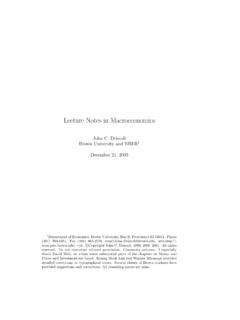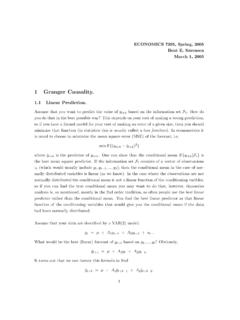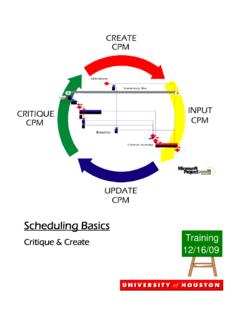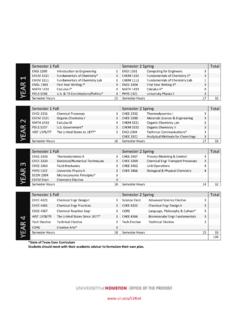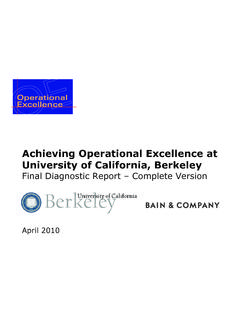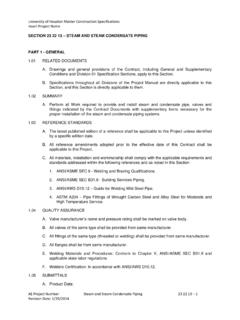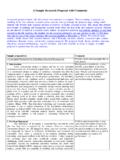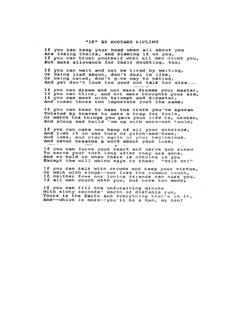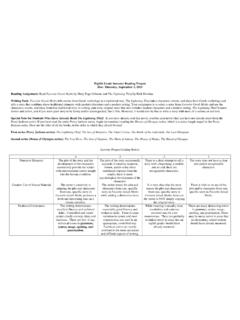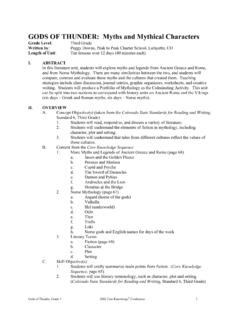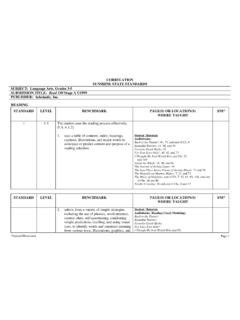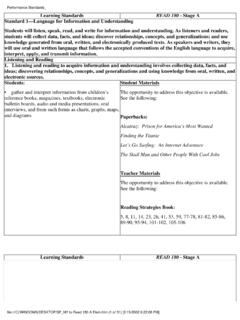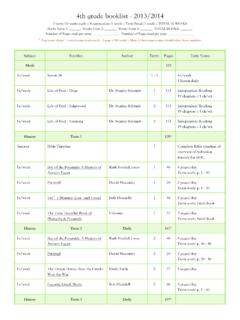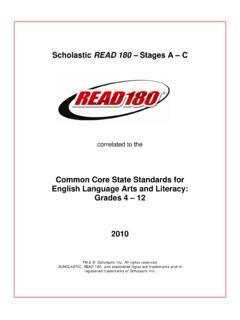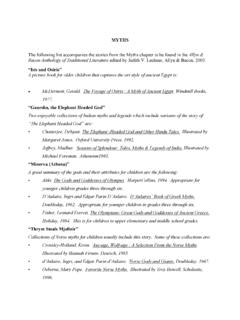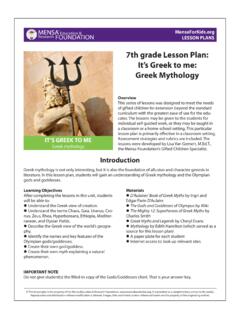Transcription of “Everybody Loves a Great Story: Mythology and the Oral ...
1 everybody Loves a Great story : Mythology and the Oral Tradition Kathy Zimbaldi Pugh Elementary School INTRODUCTION It is my belief that the very best teachers are Great storytellers; in my own academic experience, the teachers who had the most profound influence on me were the ones who told the best stories. Imagine my thrill when I saw Dr. Merrilee Cunningham s Mythology seminar listed as a 2007 HTI offering! I had the good fortune to be one of Dr. Cunningham s Advanced Shakespeare students at UHD; I knew that she also taught Mythology at the undergraduate level and mused that someday I would love to take that course. HTI presented just such an opportunity this past spring! In this seminar I had the opportunity to hear some of the greatest stories ever from one of the greatest storytellers. What an irresistible combination! As an ESL teacher in HISD, I am always looking for new ways to motivate my second language learners.
2 My curriculum unit s main thrust would be second language literacy, with teacher read aloud as the main attraction. All four language arts strands will be addressed: listening, speaking, reading, and writing. I believe I can successfully integrate all of the necessary language acquisition strategies within this type of presentation. The topic of Mythology will virtually guarantee a high level of student engagement. The stories will provide a springboard for reading and writing workshop activities designed specifically to enhance student second language development. My ESL students are of Mexican extraction exclusively; whenever possible I will make serious effort to establish cultural connections for them. OBJECTIVES: TEKS Chapter (3) Listening/speaking/appreciation. The student listens, enjoys, and appreciates spoken language. The student is expected to: (A) listen to proficient, fluent models of oral reading, including selections from classic and contemporary works (4-8); (4) Listening/speaking/culture.
3 The student listens and speaks both to gain and share knowledge of his/her own culture, the culture of others, and the common elements of cultures. The student is expected to: (B) compare oral traditions across regions and cultures (4-8) 19) Writing/writing processes. The student selects and uses writing processes for self-initiated and assigned writing. The student is expected to: (A) generate ideas and plans for writing by using such prewriting strategies as brainstorming, graphic organizers, notes, and logs (4-8); (B) develop drafts by categorizing ideas, organizing them into paragraphs, and blending paragraphs within larger units of text (4-8); (C) revise selected drafts by adding, elaborating, deleting, combining, and rearranging text (4-8). 11) Reading/literary response. The student expresses and supports responses to various types of texts.
4 The student is expected to: (A) offer observations, make connections, react, speculate, interpret, and raise questions in response to texts (4-8). Kathy Zimbaldi 169 RATIONALE My 4th grade ESL students are transitioning to instruction that is completely in English for the very first time. Many are recent arrivals; others have been taught through our school s bilingual education program. Testing demands are daunting; by February my students must take and pass a writing test that requires a working knowledge of English grammar and composition. It is my task each year to make this transition as smooth as possible by immersing my students in the four language arts strands of reading, writing, speaking, and listening. My recipe for success demands a high level of student interaction: the more students use and manipulate language, the easier second language acquisition is for them.
5 For this reason, I try to choose high interest material that will immediately engage them; using well-written stories and high quality children s literature has always proven to be the most pleasurable way to achieve the language goals. Because the students love the stories, the skills embedded in the tasks are fun and exciting for them. Using children s literature allows me to do my best sneaky teaching when students are learning and don t even know it! That the students will respond I am sure; I have dabbled in greek Mythology using the Club Chronicle series and the students have always wanted more. Although I did my best to supplement the series with classroom library selections, I (and maybe the students too) found my approach wanting. What I needed was a comprehensive and organized unit instead of the piecemeal approach I was using. Thanks to this Mythology seminar, next year s students will be able to enjoy a unit that is specifically tailored to their interests and needs.
6 UNIT BACKGROUND AND OVERVIEW I envision a three-week curriculum unit that would begin with a general historical overview of Mythology . Questions to be considered during this section are: What is a myth? How does Mythology differ from other like genres such as tall tales, legends, and fables? Are certain myths peculiar to certain groups of people? Do some cultures share similar versions of one particular type of myth? ( creation? redemption?) Part 2 of my unit would explore greek Mythology . I have dabbled lightly in this topic with students in the past using the Houston Chronicle s Club Chronicle series, and student interest is always high! The most immediate benefit derived from stories published in this format is the side by side translations in English and Spanish. English language learners of Hispanic background may use the resource to cross reference from Spanish to English when necessary.
7 This greatly enhances comprehension by providing a visual tool for locating cognates in English and Spanish, a vocabulary building activity that accelerates second language acquisition. While Part 1 of my unit will introduce students to Mythology in general; Part 2 will focus on the greek myths . Using Dauliere s visually enticing Book of greek myths as well as The Macmillan Book of greek Gods and Heroes, by Alice Low, students will be introduced to these wonderful stories that contain all of the elements of a Mexican novella: humor, vengeance, grief, jealousy, love , infatuation, etc. Students will be guided through lesson plans that explore grammar concepts, such as concrete and abstract nouns, cognate related vocabulary building exercises, and comprehension strategies that are all designed with the second language learner in mind. Zeus s family tree alone would offer a Great way to teach advance organizer study skills to my students!
8 Finally, no study of greek myths would be complete without some drama! I am hoping that my students will enjoy dressing up like gods and goddesses for some fun with Reader s Theatre. We ll assign parts and take turns pretending to be gods and mortals, and then wind things up with a greek Festival and a Feast fit for the gods. With an emphasis on food and beverages that are specific to certain myths (pomegranates, olives, apples, ambrosia, and grape juice for wine!) we can let our taste buds make some memorable language connections indeed! Houston Teachers Institute 170 Part 3 of my unit would be devoted to Mythology specifically involving the Hispanic culture. The study of myths from two indigenous groups in Mexico (Aztec and Mayan) would provide a high interest, cultural connection for my students. Part 1 What is Mythology ? It had been my intent to begin this unit with a clear definition of Mythology , complete with examples and specifics as to how myths differ from legends and folktales.
9 What began as an innocent, simple exercise resulted in the realization that defining these genres is not an easy task. Because they are labels that are often used interchangeably, definitions vary. However, most resources I consulted generally agreed (as does Dr. Cunningham) that myth involves ancient stories grounded in the sacred. Legends, while also old stories, tend to be based, however loosely, on some historical event. Folktales are entertaining stories borne from the oral tradition and have been handed down through generations of a particular culture. All, however, are part of the oral tradition of storytelling, in which the stories are not written down but memorized by the tellers/ keepers of the tale. Since the emphasis in this unit is on Mythology , this general definition above should be sufficient to satisfy this part of the unit discussion.
10 My children will learn that myths generally fall into one of two categories: 1. As an explanation for a phenomenon whose cause is not easily or readily explained. 2. As a means of providing a value system or set of cultural norms for a society. It will be important at this point to emphasize that all cultures and countries have their own mythologies, and many are similar. I plan to introduce this portion of the unit study with some video clips from HISD provides PK-12 district-wide access to this valuable teacher s resource; I often use video clips with my ESL students to generate interest and to draw in the reluctant learner. One particular clip, entitled, World History: Ancient Civilizations, will provide an excellent introduction to the word of Mythology and its purpose in the culture of a people. Although it is geared toward the older student (grades 6-12), I believe there is enough material presented in a highly entertaining visual format to engage my students and justify its use for the slightly younger English language learner.
